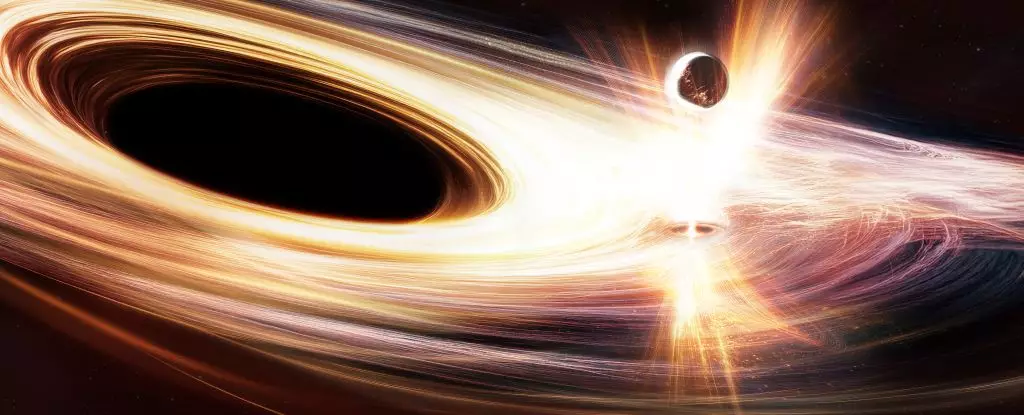Deep within the cosmos, approximately 300 million light-years from our Earth, a supermassive black hole has taken center stage in the world of astrophysics, baffling researchers and igniting excitement across the scientific community. Named Ansky, a designated candidate for extraordinary observation, this black hole resides at the nucleus of the galaxy SDSS1335+0728. Since its remarkable awakening in 2019, Ansky has exhaled a series of striking eruptions, each one brighter and more powerful than what conventional models could predict. These eruptions, characterized by bursts of X-rays that are ten times longer and a hundred times more energetic than typical phenomena observed in the cosmos, challenge our understanding of these enigmatic entities.
Redefining Eruptions and Periodicity
Traditional models suggested that the periodic activity of supermassive black holes occurs sporadically, often triggered by celestial objects straying too close—including stars, planets, or even other black holes. However, the behavior exhibited by Ansky diverges sharply from this norm. Joheen Chakraborty, an astrophysicist at MIT, describes the events unfolding around Ansky as “not just out of the ordinary, but pushing our theoretical frameworks to their limits.” With each eruption spaced approximately 4.5 days apart, Ansky’s irregular ramp-up and sustained intensity create a tantalizing mystery that cannot easily be reconciled with prior expectations.
One might say this black hole embodies the phrase “more questions than answers.” Instead of merely consuming matter from its surroundings, Ansky appears to be participating in a cosmic dialogue with its environment—an idea previously thought too outrageous for consideration in the study of these celestial giants.
The Duality of Black Hole Behavior
Supermassive black holes, such as the one at the heart of our own Milky Way galaxy, can toggle between states of intense activity and extended periods of dormancy. Each state is crucial not only for the black hole itself but also for the galactic ecosystem surrounding it. During times of quiescence, black holes may seem like passive overseers, while in moments of fervent activity, they can catalyze star formations and shape the chemical evolution of galaxies.
One of the most profound implications of Ansky’s awakening is the influence it may have on our comprehension of black hole formation and growth. As Lorena Hernández-García, a prominent figure in research surrounding Ansky, remarks, understanding the nature of these eruptions could reshape our theories underpinning cosmic evolution.
A Light in the Darkness: The Nature of Eruptions
Exploring the energetic emissions and the surrounding gravitational forces of Ansky reveals a riveting portrait of cosmic phenomena. Black holes themselves do not emit light; instead, they become sources of dazzling radiation generated by the superheated matter swirling at their thresholds. This accretion process often produces an array of wavelengths, from infrared to X-rays, emitting a flurry of activity that can dominate our observations of these energetic entities.
What sets Ansky apart is the anomalous brightness and duration of its eruptions, which defies scientific intuition. The observed manifestations appear to be independent of the typical triggered responses many astrophysicists expected. This novel behavior suggests that exploring the boundaries of our understanding might lead to groundbreaking discoveries regarding how supermassive black holes engage with their surroundings. Erwan Quintin of the European Space Agency emphasizes that these repetitive bursts might also bear insight into gravitational waves—an exciting prospect for future observational endeavors.
Implications for Future Research
The unique behavior of Ansky serves as a clarion call for researchers to delve deeper into the enigma of supermassive black holes. Stratagems previously relied upon may no longer suffice; scholars across the globe must recalibrate their focus. We are on the cusp of a profound understanding, yet we still need to amass data and analyze the shifting patterns of Ansky’s eruptions to uncover the underlying truths.
In many ways, Ansky epitomizes the dynamic interplay between the known universe and the endless possibilities it harbors. Each revelation leads to a new set of questions, and the excitement of discovery is magnified by the prospect of rewriting our understanding of black holes, and the complex mechanisms that drive their erratic existences.
As Ansky takes the spotlight in astronomical research, it invites not only admiration but also a rigorous examination of our theoretical frameworks and assumptions. The race is now on—not only to fully comprehend Ansky’s behavior but also to gain deeper insights into the universe itself, revealing secrets that have lain dormant in the cosmic abyss for eons.


Leave a Reply